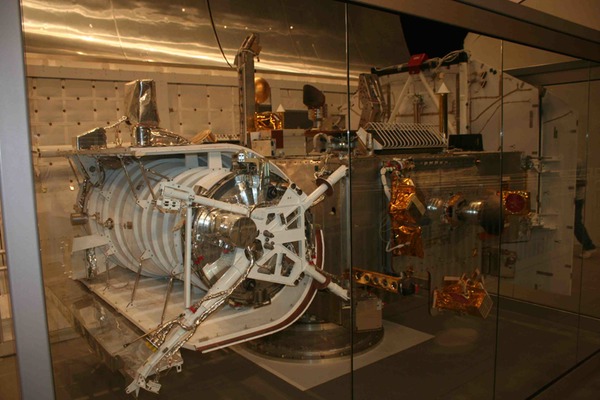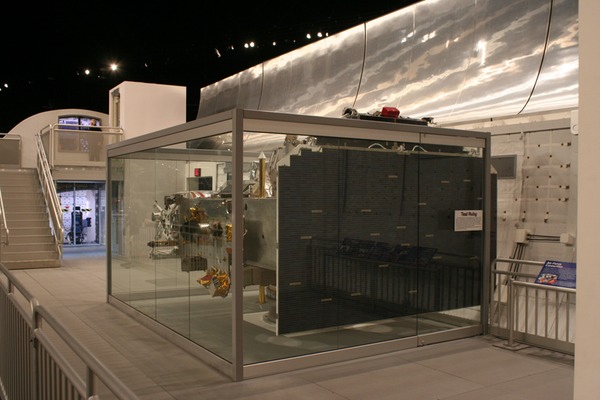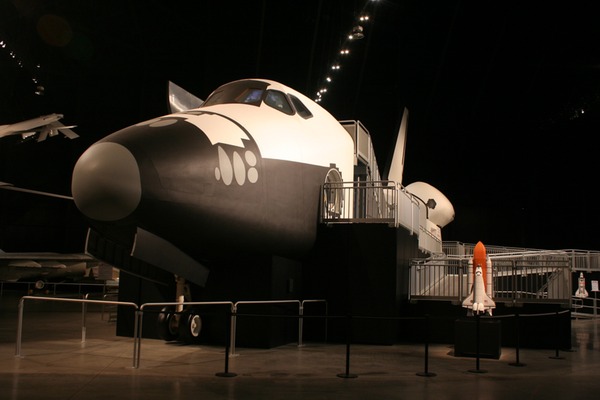 The Teal Ruby spacecraft on display at the National Museum of the United States Air Force. (credit: D. Day) |
Ugly little gem: The Teal Ruby satellite
by Dwayne A. Day
Monday, September 15, 2014

Satellites are designed to be functional, not pretty. But there is no denying that some are better looking than others. The Air Force’s Defense Support Program (DSP) satellites, for instance, are big, spinning cylinders of blue with a silver telescope pointing down at an angle, giving them a certain lopsided elegance. Similarly, some large modern comsats have giant gold antennas that practically glitter in the night sky. But nobody would ever call Teal Ruby pretty. It looks like something a kid would assemble in his garage using old air conditioner parts. And now it’s on display in the National Museum of the United States Air Force in Dayton, Ohio, ready for its close-up.
If you haven’t heard of Teal Ruby, that’s understandable. It was supposed to launch in the early 1980s, never did, and got stuck in a warehouse so that the Air Force could study how it would degrade—sort of like watching a car rust. But at one time Teal Ruby was notorious. It was supposed to be a relatively inexpensive test satellite, but ran way over budget and behind schedule. It was supposed to fly on the first West Coast shuttle launch. But even before Challenger came apart in a cold Florida sky and the Air Force canceled all plans for launching shuttles from California, Teal Ruby’s purpose was in doubt. This gem was supposed to do a lot of things, and it never got the chance.
| At one time Teal Ruby was notorious. It was supposed to be a relatively inexpensive test satellite, but ran way over budget and behind schedule. |
Teal Ruby began as a collaborative effort between the Defense Advanced Research Projects Agency (DARPA)—a separate research and development organization within the Pentagon—and the US Air Force. DARPA’s job was to develop advanced and innovative technologies; the agency is perhaps best known for developing stealth technology used in the F-117 airplane.
The Air Force managed the Space Technology Program, which included substantial participation by the Navy and Army and involved launching small experimental payloads and small satellites into orbit, testing everything from solar panels to electronics to lightweight materials. The Space Test Program had an annual budget of around $15–20 million in the mid 1970s. But the office was about to take on several bigger and much more expensive projects.
 The Teal Ruby spacecraft on display at the National Museum of the United States Air Force. (credit: D. Day) |
Beginning around 1976, DARPA undertook a new project called HALO, which stood for High Altitude Large Optics. HALO initially involved competitive 19-month studies conducted by Grumman Aerospace and Hughes Aircraft. The two companies were evaluating the feasibility of a high-resolution optical and infrared warning and surveillance satellite system. According to one person knowledgeable of the project at the time, HALO was a very ambitious program with the ultimate goal of developing truly massive diameter optics in geosynchronous orbit.
But HALO also involved evaluating the new technology of charge-coupled devices, or CCDs. CCDs are now common for a host of commercial products, from digital cameras to cellphone cameras to videorecorders. But in the 1970s they were still an immature technology that offered great promise for military use.
One of the military benefits of CCD sensors is that they can be used to “stare” at a large area. Other sensors in use at the time, such as the linear detection arrays on the Defense Support Program missile warning satellites, had to sweep over an area of interest like a rotating radar beam. This resulted in a delay between each sweep over a target. For instance, the DSP satellite rotated six times per minute, meaning a delay of ten seconds between each detection of a single infrared source, such as a hot ICBM rising out of its silo at high speed. In addition, only a limited amount of energy reached the detector, reducing its sensitivity and accuracy. A staring sensor could return target data continuously, enabling more accurate detection and tracking. The sensor could operate in staring mode or follow a repeating ground track to cover more area.
DARPA also had a number of projects underway to develop CCD technology for detecting infrared sources, including Teal Jade, which was to investigate the detection from space of small missile launches; and Teal Amber, to evaluate CCDs for tracking space objects and missiles from ground based sensors. These were experimental projects, not operational military hardware development efforts.
| DARPA and Air Force officials decided to conduct the project development in a unique way in order to keep costs low and development time short. |
In October 1976, DARPA selected Rockwell International and a team led by Lockheed Missiles & Space Company for competitive studies of a Teal Ruby infrared sensor. The Lockheed team also included Grumman Aerospace and Carson Alexiou, which were already working on a mosaic infrared sensor for ballistic missile detection. The Teal Ruby sensor was to be able to look in several infrared bands. DARPA and the Air Force were particularly interested in two of these spectral bands. The first, designated Blue Spike, was the spot in the infrared spectrum where aircraft emissions peak and where atmospheric absorption is limited. A second wavelength was also of interest to the military. It was known as Red Spike. Although existing information is unclear, it appears as if Teal Ruby was intended to not only detect aircraft in afterburner, when they produced the highest temperatures, but also in normal cruise flight.
Until that time, it was the US Navy that had demonstrated an interest in using satellites to track aircraft and possibly cruise missiles. The Navy evaluated a program known as Clipper Bow in the early 1970s that would have used radar to detect aircraft and missiles, but abandoned the project as too expensive and limited in capability.
 The Tel Ruby spacecraft is displayed with a Space Shuttle trainer at the National Museum of the United States Air Force. (credit: D. Day) |
Later, in the 1980s, the Air Force leadership developed an interest in what was eventually called Space Based Wide Area Surveillance (SBWAS), essentially an “air traffic control system in sky” that could detect all kinds of aircraft. But Teal Ruby appears to have been primarily an experimental program that grew out of military enthusiasm over CCD technology, not the result of a clearly defined military requirement to track aircraft.
In October 1977, the Air Force and DARPA signed a memorandum of agreement to fly an advanced infrared sensor in space. The original cost was $60 million for a three-year development effort, with the goal of launching the satellite aboard the Space Shuttle in 1980. That same month, DARPA selected Rockwell International to build the infrared sensor.
The original plan was for a 910-kilogram (2,000-pound) spacecraft to be launched into a 740-kilometer (400-nautical-mile) orbit inclined 72.5 degrees. Project officials wanted to use flight-proven hardware as much as possible, and the Air Force was also investigating the development of a standard satellite to be carried into orbit by the Space Shuttle to test various sensors.
The satellite to carry the Teal Ruby sensor was initially designated P80-A, then renamed P80-1. Four companies competed for the satellite contract: Ball Brothers, Grumman Aerospace, RCA, and Rockwell International’s Space Division. In late 1977, the Air Force declared Rockwell the satellite contract winner and on February 18, 1978, the company was awarded an initial $18.9-million contract to build a spacecraft to carry the Teal Ruby infrared sensor and several secondary payloads. The spacecraft was also designated Air Force Program 888, or more commonly AFP888, a designation that later apparently officially replaced P80-1.
DARPA and Air Force officials decided to conduct the project development in a unique way in order to keep costs low and development time short. The project was supposed to be fast-track, without standard military specifications and defining only top-level system specifications. Detailed cost reporting was not initially included in the contract. The project also did not include reserves or contingency funds, nor did it include an independent technical assessment to compare the level of technology development required to what was already available. These decisions later came to haunt the program development—and cost the American taxpayers a lot of money.
When Rockwell was awarded the satellite contract, the company was already developing the Teal Ruby sensor payload. The payload consisted of a lightweight, large aperture telescope with an advanced cryogenic optical system that cooled it to –226 degrees Celsius (–375 degrees Fahrenheit). The heart of the payload would be the largest mosaic focal plane ever built, consisting of high-performance monolithic infrared CCD-multiplexer arrays for transducing the infrared radiation into electric signals, detecting sources in the 2–16 micron band. The payload also included an on-board signal processor to eliminate most background clutter, assemble target impulses into tracks, and send only the pertinent data to the Space System Division’s Mission Operations Center in Seal Beach, California. The raw data would also be transmitted to the ground so that it could be separately processed later and compared to the onboard processing.
| Teal Ruby was soon encountering major problems that had a bigger impact on its schedule than the unavailability of the launch site. |
By 1978 and 1979 several new Space Test Program projects were overrunning their budgets. The two biggest offenders were Teal Ruby and an infrared satellite intended to detect and track satellites in higher orbit named SIRE. In September 1979, midway through its three-year development program, the Air Force canceled SIRE. Program officials now considered flying the SIRE sensor inside the shuttle payload bay. Unfortunately, by November 1978 Teal Ruby was in trouble as well.
When Teal Ruby was started in 1977, the Air Force planned to launch the spacecraft on the fifth shuttle flight, then scheduled for March 1980. At the time NASA was considering a possible shuttle flight to reboost the falling Skylab space station and, at one point, the Skylab mission became the fifth mission and the Teal Ruby launch slipped to sixth. By October 1977, however, delays in the Teal Ruby program led to the launch being postponed, possibly to the eighteenth shuttle flight scheduled for July 1981. This delay would increase the cost for the Air Force because if the payload flew while the shuttle was still in its testing phase, the military would not have to reimburse NASA for the cost of the flight. But by the eighteenth mission the shuttle was scheduled to be “operational,” meaning that NASA would charge the Air Force for its use.
By January 1979, with sensor and spacecraft development underway, the Teal Ruby launch was scheduled for 1981. But in the summer of 1979 Rockwell suffered a setback when one of its subcontractors, Spacetac, Inc., went bankrupt. Spacetac was building a signal conditioning unit and a data processing system. Rockwell took over the development of these systems. Although the loss of the subcontractor was bad, it only caused a delay of a few months. However, program officials had to slip the launch by a full year in order to preserve the mission’s safety margins. If the satellite became stranded in a lower orbit due to a propulsion failure, the solar arrays could not provide enough power for experiments to be conducted for a long time unless the satellite was launched in the summer or winter months. So the launch was slipped to November 1982.
By April 1979, Congress eliminated most of the funds for the Mosaic Sensor Development Program that was supposed to produce an experimental sensor before the actual flight object. Air Force Headquarters directed that the development effort skip building an experimental Teal Ruby sensor and proceed directly to fabrication and launch of a prototype sensor with some operational utility. This proved to be another major mistake in the development program.
Because of rising costs, DARPA officials considered testing the Teal Ruby sensor on the Space Shuttle, but concluded that three to six missions would be required to get as much experience as one year of satellite operations. In addition, the shuttle would fly in a lower orbit that was not optimum for testing.
In September 1979, after a review of Teal Ruby’s schedule and costs, Undersecretary of Defense William J. Perry approved the development program and the launch aboard the shuttle.
When Teal Ruby had been initiated, NASA and some Air Force officers were still optimistic about he Space Shuttle’s capabilities and expected it to be launched in 1979 or 1980 and to soon afterwards begin launching from Vandenberg Air Force Base. Starting in the late 1970s, the Air Force began construction of a massive new space launch facility at Vandenberg’s Space Launch Complex 6, or “Slick-6.” Slick-6 had originally been developed for the canceled Manned Orbiting Laboratory program. Later it was to be converted to launch Titan III rockets. The Air Force determined that by converting it to shuttle launches they could save $100 million compared to building an entirely new facility.
But just as the Space Shuttle began experiencing delays in the later 1970s—its first launch would take place over two years later than planned—Slick-6 also began experiencing delays. Even if Teal Ruby had experienced no development problems, there was no way that either the shuttle or the launch facility would be ready in time. However, Teal Ruby was soon encountering major problems that had a bigger impact on its schedule than the unavailability of the launch site.
page 2: mounting problems >>
|